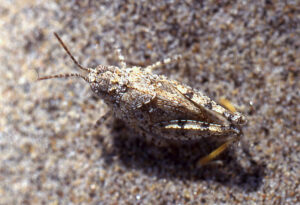Note: All links below go to external sites.
Howdy, BugFans,
The BugLady found this grasshopper nymph in the dry sand zone of a Lake Michigan beach about 25 years ago (apologies – she’s never learned the secret handshake of making a color slide into a digital image). For years she used it as a grand example of camouflage in her program about adaptations. The nymph is not only the color of the sand, it seems to have a sandy texture, too
- https://bugguide.net/node/view/970587/bgimage
- https://bugguide.net/node/view/381375/bgimage
- https://bugguide.net/node/view/1546956/bgimage
- https://bugguide.net/node/view/1490126/bgimage
Adults are also camouflaged, but, of course, it’s up to the grasshopper to sit in the right place
- https://bugguide.net/node/view/826240/bgimage
- https://bugguide.net/node/view/994121/bgimage
- https://bugguide.net/node/view/543912/bgimage
- https://bugguide.net/node/view/349932/bgimage
- https://bugguide.net/node/view/1490122/bgimage
- or not https://bugguide.net/node/view/1407365/bgimage
The Seaside grasshopper (Trimerotropis maritima) is a member of the Short-horned grasshopper family Acrididae (620 species in North America; 8,000 total worldwide), a mostly open-spaces/grassland-loving bunch that includes many of our familiar (and notorious) grasshoppers. It’s in the Band-winged grasshopper subfamily Oedipodinae (about which taxonomists are dickering), and is one of 43 members of the genus Trimerotropis (more dickering). Most live in dry, open, sunny habitats.
Seaside grasshoppers are also called Maritime, Sand, and Citrus-winged grasshoppers, Dune locusts, and, in French, Criquet maritima. They’re found by the seaside but also pretty far away from it – from southern Ontario southwest to northwestern Arizona, east through Texas and around the Gulf of Mexico to Florida, and north along the Atlantic Coast. Older publications divide the species into two subspecies – Trimerotropis maritima maritima and Trimerotropis maritima interior, with the range divisions you would expect.
Bugguide.net lists their habitat as “Sandy areas, mostly on beaches or in dunes, in sandy pine barrens, on riverine sand bars, in dry sandy washes, or sometimes along sandy dirt roads in old fields, and in similar disturbed sandy places. The key word is ‘sand’”. Even though Seaside grasshoppers are strong fliers that fly higher and longer than many other grasshopper species, they prefer to stay within their sandy haunts.
In Wisconsin, look for them along the southern shores of Lake Michigan and sandy areas along the banks of the Wisconsin and Chippewa Rivers. The similar Lake Huron locust (Trimerotropis huroniana) replaces the Seaside grasshopper in Door County, WI and on the northern shores of Lakes Michigan and Huron, but they don’t really cohabitate, and scientists don’t know what strategy one uses to exclude the other from its range. Though it is not presently being monitored, the Seaside grasshopper is a species of special concern in Wisconsin, and the Lake Huron locust is considered imperiled/endangered.
They range in size from about an inch to 1.7;” males are smaller than females, and individuals’ lightness/darkness/speckling can be quite variable, even within the same area.
In late summer and early fall, males woo females from afar by short but conspicuous flights that involve flashing their colorful wings and “snapping” them to produce a soft rattle (they are able to locate well-camouflaged, motionless females, and scientists suspect that she may be calling them with pheromones). They land and switch to up-close signals like twitchy leg movements and chirps that they produce by rubbing a rear leg against a front wing.
If she responds in the affirmative, the spermatophore he transfers to her includes some nutrition in the form of proteins that she will absorb and use when she forms eggs. She covers each cluster of eggs with a layer of foam that hardens and protects the egg pod, which is tucked into the sand at the base of a plant. Both males and females will continue to mate until the weather gets too cold.
The eggs overwinter and hatch in spring (if the area where she lays them becomes flooded, the eggs will hatch when the water goes down), and the nymphs molt several times through summer until they reach adulthood.
American beach grass (Ammophila breviligulata) is a favorite food plant (click on any picture to start a slide show https://www.minnesotawildflowers.info/grass-sedge-rush/american-beach-grass – great website), and it was a common plant in the interdune region where the BugLady took her picture (until the lake level rose – and rose). Seaside grasshoppers will also eat parts of some broad-leaved plants. The BugLady is always interested in finding out both what the featured bug eats and who eats it. According to the University of Michigan’s Animal Diversity Web “This species relies on its cryptic coloration as its primary defense against predators. Nymphs can jump quickly, and adults will fly if approached too closely. They prefer to land on sand, rather than vegetation, probably to better use their camouflage. We have no information on the particular predators of this species. There is no indication that Trimerotropis maritima has chemical defenses, so probably any insectivorous predator that can catch one might eat it.”
[How cool to have a “seaside/maritime” species in Wisconsin! But if you scan the scientific names of the plants and animals that call the state home, you’ll find all kinds of geographical allusions like pensylvanicus (only two “n’s” – long story), virginiana, marilandica, maritima, mexicanus, alpina, labradoricum, norvegica, groenlandica, borealis and lots of canadensis.]
Fun fact about Seaside grasshoppers: Temperatures on the sand can get chilly pretty quickly after the sun goes down. Seaside grasshoppers will bury themselves in the sand (except for their heads) to take advantage of its residual heat and will emerge the next day when the sun warms it.
–The BugLady
